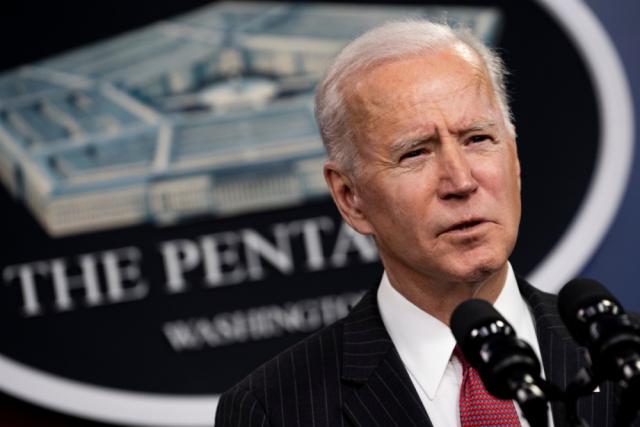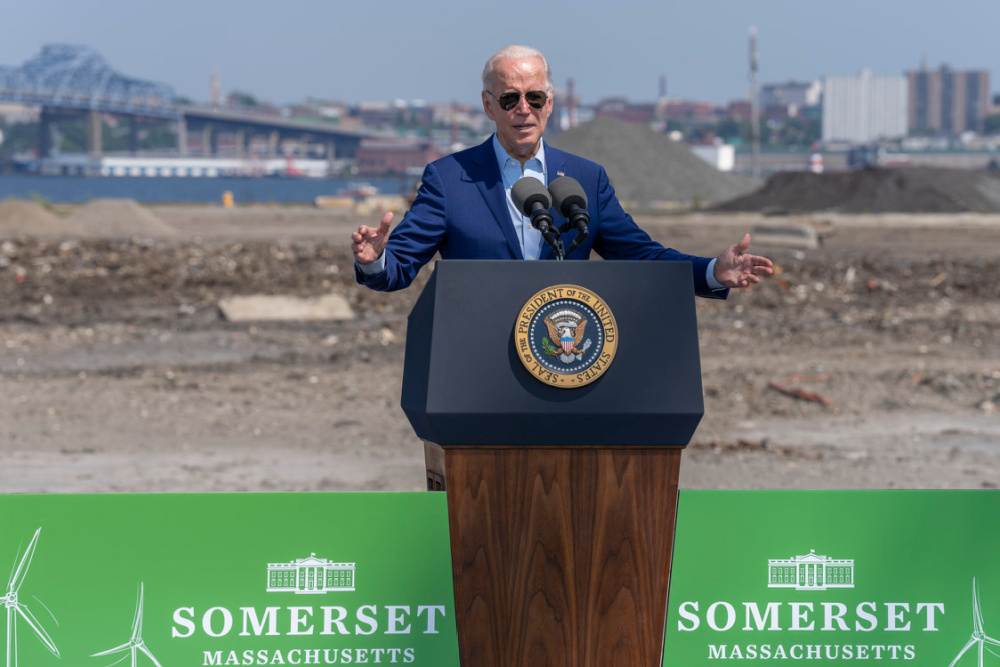
Short of a congressional miracle, it’s unlikely much will be done on climate before the midterms this fall. And if Democrats lose their majority, the odds against the president’s climate plan will become greater. (Source: Image of U.S. President Joe by BiksuTong / Shutterstock.com)
U.S. President Joe Biden’s chances of legislating something meaningful to combat climate change may be lost.
His best opportunity flamed out in recent days with as congressional negotiations came to a screeching halt on a provision to add $300 billion-plus in clean energy tax credits to the July budget reconciliation package.
“There’s nothing really that can be sort of substituted for this,” Evercore policy analyst Tobin Marcus told Hart Energy. “There’s not another kind of tool in the arsenal for Biden—without congressional authorization—that anyone thinks is going to do nearly as much to bolster clean energy.”
Talks Fall Apart
Despite his misgivings about backing the president’s $2 trillion Build Back Better package, which included major climate provisions, Sen. Joe Manchin (D-W.V.) in recent weeks has been at the negotiating table with Senate Majority Leader Charles Schumer (D-N.Y.) and bipartisan group of senators.
But Manchin torpedoed talks last week. The U.S. Bureau of Labor Statistics had announced a 9.1% increase in the Consumer Price Index in June, which indicated the inflation rate is too high, Manchin reportedly told Schumer. He would not endorse new spending given the economic circumstances.
In the evenly divided Senate, that likely dooms the $300 billion package, insiders say. Short of a congressional miracle, it’s unlikely much will be done on climate before the midterms this fall. And if Democrats lose their majority, the odds against the president’s climate plan will become greater.
“You know that there’s no way you’re going to get bipartisan agreement to do $300 billion worth of what had been Democratic Party line priorities.”—Tobin Marcus, Evercore
But there are a few things Biden could do to address some of his goals, Marcus said.
Another reconciliation bill could be a vehicle for climate mechanisms. Growing chatter around the capitol indicates that is a possibility in October when a new fiscal year begins.
“But that strikes me as very, very difficult to land given all the challenges,” including the impending midterm elections, Marcus said.
Another possibility includes passage of a new, bipartisan tax bill—another long shot.
“You know that there’s no way you’re going to get bipartisan agreement to do $300 billion worth of what had been Democratic Party line priorities,” Marcus said.
Or, if the Republicans prevail in November, they would want to pass a tax cut package.
“Tax cuts are usually on the Republican policy agenda,” Marcus said, adding that Biden’s clean energy tax credits could find a way into those negotiations.
Delayed executive action on “emergency”
Biden on July 20 declared that climate change is an emergency, but he stopped short of taking executive action. Instead, he leaned on a funding mechanisms for clean energy projects put in place during the first half of his administration.
During his term, the federal government has invested more than $4 billion to assist the 25 hardest-hit coal communities, he said. With the infrastructure law, the government is spending on clean hydrogen, nuclear, and carbon capture. And lawmakers have secured $16 billion to clean up abandoned mines and wells, Biden said.
But there is resolute presidential action on climate to come, he said.
“When it comes to fighting the climate change, I will not take ‘no’ for an answer,” the president said. “And in the coming weeks, I’m going to use the power I have as president to turn these words into formal, official government actions through the appropriate proclamations, executive orders, and regulatory power that a president possesses.”

Biden delivered his remarks on July 20 from the Brayton Point Power Station in Somerset, Mass. The location—once the largest coal-fired power plant in New England—served to underscore Biden’s clean energy point.
Brayton Point closed down five years ago, it’s 50 years in fossil fuels in the rearview mirror; it is reemerging now to manufacture heavy-duty subsea cables to tie offshore wind farms to existing grids.
Meanwhile, the U.S. Bureau of Ocean Energy Management reported it has identified almost 735,000 acres offshore Texas and Louisiana for potential wind energy development in the Gulf of Mexico (GoM).
The acreage is a sliver of the initial 30 million-acre area in the GoM the Interior Department opened for public comment in October 2021.
On July 20, Biden announced $2.3 billion—the “largest investment ever”—worth of federal funding for the Building Resilient Infrastructure and Communities program. The administration also released $385 million to states through the Low-Income Home Energy Assistance Program to help families with household energy costs.
Climate change “is literally, not figuratively, a clear and present danger,” the president said.
Extreme weather events resulting from climate change cost the U.S. $145 billion in damages last year alone, according to Biden. Moreover, extreme weather is damaging domestic military installations, presenting a national security threat, he said. Extreme weather disrupts supply chains, putting the economy at risk, too.
“Climate change is literally an existential threat to our nation and to the world,” Biden said.
But for now, Congress has failed in fulfilling its responsibilities, he added.
“Not a single Republican in Congress stepped up to support my climate plan. Not one,” he said. “If we don’t keep it below 1.5 degrees centigrade, we lose it all. We don’t get to turn it around. And the world is counting on us.”
Recommended Reading
Marketed: Team Operating Gulf Coast Opportunity
2024-03-19 - Team Operating LLC has retained PetroDivest Advisors for the sale of certain oil and gas leasehold and related assets spanning multiple counties in Texas, Louisiana and Mississippi.
Marketed: Rock Oil Holdings Mineral, Royalty Opportunity in Midland Basin
2024-04-09 - Rock Oil Holdings has retained PetroDivest Advisors for the sale of a mineral and royalty opportunity in Howard County, Midland Basin.
NOG Closes Utica Shale, Delaware Basin Acquisitions
2024-02-05 - Northern Oil and Gas’ Utica deal marks the entry of the non-op E&P in the shale play while it’s Delaware Basin acquisition extends its footprint in the Permian.
Vital Energy Again Ups Interest in Acquired Permian Assets
2024-02-06 - Vital Energy added even more working interests in Permian Basin assets acquired from Henry Energy LP last year at a purchase price discounted versus recent deals, an analyst said.
California Resources Corp., Aera Energy to Combine in $2.1B Merger
2024-02-07 - The announced combination between California Resources and Aera Energy comes one year after Exxon and Shell closed the sale of Aera to a German asset manager for $4 billion.



